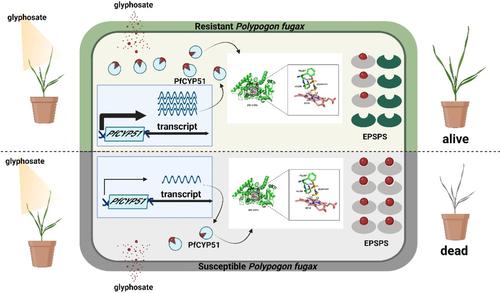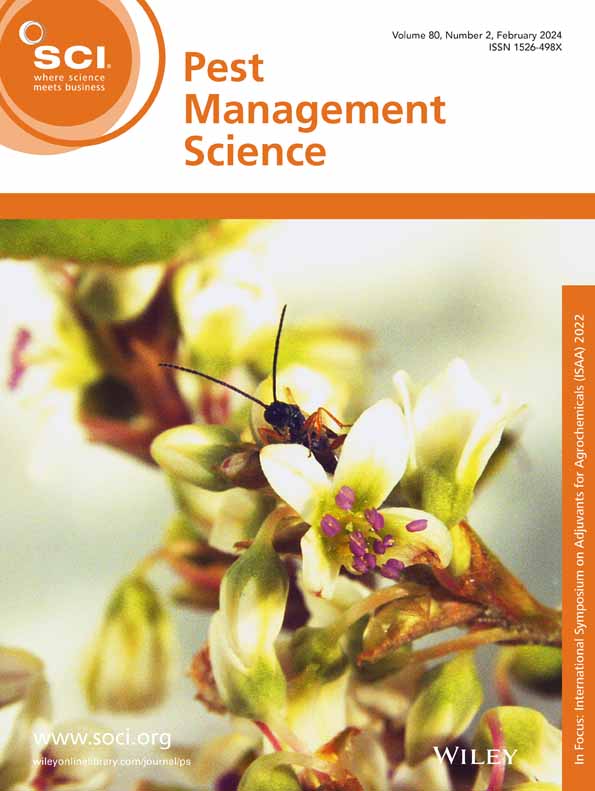求助PDF
{"title":"First case of glyphosate resistance in Polypogon fugax: possible involvement of P450‐based mechanisms","authors":"Wen Chen, Yuxi Liao, Dingyi Bai, Qin Yu, Lianyang Bai, Lang Pan","doi":"10.1002/ps.8704","DOIUrl":null,"url":null,"abstract":"BACKGROUND<jats:italic>Polypogon fugax</jats:italic> has evolved resistance to multiple herbicides in China, yet there has been no documented case of glyphosate resistance. A putative glyphosate‐resistant <jats:italic>P. fugax</jats:italic> (HN‐R) population was collected from canola fields in Hunan Province, China, surviving glyphosate treatment at the field‐recommended rate [540 g acid equivalent (a.e.) ha<jats:sup>−1</jats:sup>]. The aims of this study were to elucidate the resistance level and mechanism of HN‐R population.RESULTSDose–response and shikimic acid assays indicated that the HN‐R population has developed a low‐level resistance (up to 4.6‐fold) to glyphosate, compared to two glyphosate‐susceptible populations (HN‐S and SC‐S). No evidence of <jats:italic>EPSPS</jats:italic> gene mutations and differential <jats:italic>EPSPS</jats:italic> gene expression were found in association with the resistance. However, pre‐treatment with the known cytochrome P450 monooxygenases (P450s) inhibitor, malathion, reversed glyphosate resistance in the HN‐R population. Transcriptomic and reverse transcription quantitative polymerase chain reaction (RT‐qPCR) analyses showed up‐regulation of the <jats:italic>PfCYP51</jats:italic> and <jats:italic>PfABCG25</jats:italic> genes in the HN‐R population. Expression of <jats:italic>PfCYP51</jats:italic> in yeast cells significantly enhanced glyphosate tolerance, whereas expression of <jats:italic>PfABCG25</jats:italic> did not. Molecular docking experiments suggest that PfCYP51 may catalyze glyphosate metabolism.CONCLUSIONThis is the first report of glyphosate resistance in <jats:italic>P. fugax</jats:italic>, with evidence suggesting P450 involvement in this resistance. This study enhances our understanding of herbicide‐resistant weeds and provides valuable insights into the management of glyphosate‐resistant weeds in agriculture. © 2025 Society of Chemical Industry.","PeriodicalId":218,"journal":{"name":"Pest Management Science","volume":"47 1","pages":""},"PeriodicalIF":3.8000,"publicationDate":"2025-02-06","publicationTypes":"Journal Article","fieldsOfStudy":null,"isOpenAccess":false,"openAccessPdf":"","citationCount":"0","resultStr":null,"platform":"Semanticscholar","paperid":null,"PeriodicalName":"Pest Management Science","FirstCategoryId":"97","ListUrlMain":"https://doi.org/10.1002/ps.8704","RegionNum":1,"RegionCategory":"农林科学","ArticlePicture":[],"TitleCN":null,"AbstractTextCN":null,"PMCID":null,"EPubDate":"","PubModel":"","JCR":"Q1","JCRName":"AGRONOMY","Score":null,"Total":0}
引用次数: 0
引用
批量引用
Abstract
BACKGROUND
Polypogon fugax has evolved resistance to multiple herbicides in China, yet there has been no documented case of glyphosate resistance. A putative glyphosate‐resistant
P. fugax (HN‐R) population was collected from canola fields in Hunan Province, China, surviving glyphosate treatment at the field‐recommended rate [540 g acid equivalent (a.e.) ha
−1 ]. The aims of this study were to elucidate the resistance level and mechanism of HN‐R population.RESULTSDose–response and shikimic acid assays indicated that the HN‐R population has developed a low‐level resistance (up to 4.6‐fold) to glyphosate, compared to two glyphosate‐susceptible populations (HN‐S and SC‐S). No evidence of
EPSPS gene mutations and differential
EPSPS gene expression were found in association with the resistance. However, pre‐treatment with the known cytochrome P450 monooxygenases (P450s) inhibitor, malathion, reversed glyphosate resistance in the HN‐R population. Transcriptomic and reverse transcription quantitative polymerase chain reaction (RT‐qPCR) analyses showed up‐regulation of the
PfCYP51 and
PfABCG25 genes in the HN‐R population. Expression of
PfCYP51 in yeast cells significantly enhanced glyphosate tolerance, whereas expression of
PfABCG25 did not. Molecular docking experiments suggest that PfCYP51 may catalyze glyphosate metabolism.CONCLUSIONThis is the first report of glyphosate resistance in
P. fugax , with evidence suggesting P450 involvement in this resistance. This study enhances our understanding of herbicide‐resistant weeds and provides valuable insights into the management of glyphosate‐resistant weeds in agriculture. © 2025 Society of Chemical Industry.



